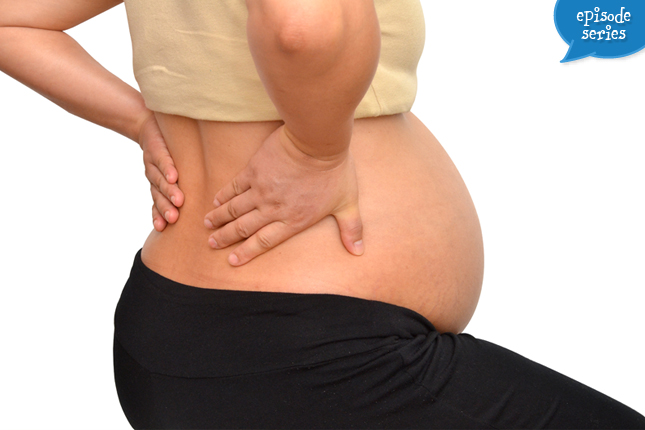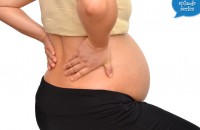Preggie Pals
Managing Pregnancy Discomfort: Physical Therapy
[00:00:00]
Please be advised, this transcription was performed from a company independent of New Mommy Media, LLC. As such, translation was required which may alter the accuracy of the transcription.
[Theme Music]
DESTINY BOCHINSKI: Pregnancy is a time of growing new life and a dramatic change in a woman’s body. It is also a common time of aches and pains for the pregnant mother. But does it have to be? Are the common complaints of back and pelvic pain and other common pregnancy discomforts treatable? How can physical therapy help an expecting mother? I am Destiny Bochinski, a Doctor of Physical Therapy at Scripps Out-patient Clinic in Encinitas. And today we will explain how physical therapy can help and promote a more comfortable pregnancy for you. This is Preggie Pals, episode 77.
[Theme Music/Intro]
ANNIE LAIRD: Welcome to Preggie Pals broadcasting live from the Birth Education Center of San Diego. Preggie Pals is your weekly online on-the-go support group for expecting parents and those hoping to become pregnant. I am your host Annie Lalrd. Would you like bonus content after each show, great give aways and discounts? Then join our Preggie Pals club. You will also get a free subscription to pregnancy magazine. See our website www.preggiepals.com for more information. Another way for you to stay connected is by downloading our free Preggie Pals App available in the Android and iTunes market place. If you don’t live in San Diego but you want to be a panelist on our show you still can be. You can participate through our virtual panelist program. Our Preggie Pals producer Stephanie is here to tell us more about it today.
STEPHANIE SAALFELD: Hi, okay. So we just want you to like our Preggie Pals facebook page and follow us on twitter and when you use twitter, please use the #preggiepalsvp. We will be posting sneak preview questions on facebook and twitter about the week before we record our shows and we would love to have your input. For more information you can go to www.preggiepals.com, under the community tab and you will find ‘be a virtual panelist’ for more information.
ANNIE LAIRD: Great! Thanks Steph. Well today of our panelists we have Sunny and myself and Stephanie. Our expert panelist for today Destiny Bochinski, thank you for being here today. So let’s go around to just to introduce yourselves. I am Annie Lalrd. I am going to be taking over at the beginning of the year once my baby is born and Sunny’s babies are born. So I am going to be taking over hosting duties on Preggie Pals from Sunny. I am very excited about it.
SUNNY GAULT: I am excited too.
ANNIE LAIRD: Yeah.
SUNNY GAULT: I am excited to pass the torch.
ANNIE LAIRD: Yeah. Oh Sunny is to be still involved in the show going to with New Mommy Media as the business person. I just get to sit here and do here and do what I do best which is talk a lot. So and facilitate discussions which I think I am really going to adjust. So we are starting up here before the babies come, try just to get me into that.
So again I am Annie Laird. I am 35. My day job is a government contractor. My due date for my, its my third baby, is here mid-October. We don’t know the gender of the baby. We are going to find out then. I have two other children. Two daughters, my eight-year-old Clara and my one-year-old Lucy and I am planning a homebirth.
SUNNY GAULT: Alright! Hey, everyone I am Sunny. And I just get to sit back and be a panelist today on the show. So excited! I am 35 years old. I am the owner of New Mommy Media which produces Preggie Pals, Parent Savers’, The Boob Group and coming in January Twin Talks which is all about twins and the reason we are launching the show is because I am pregnant with twins and there is not enough information online of being pregnant and raising twins. So we are hoping to change that.
I have two little boys at home, Sayer who is just over three-years-old, Urban who is about to seventeen months. And again I am pregnant with identical twin girls so I get the other side of the gender here now. Two boys and two girls and then we are done. We are done having babies after this. And these babies are going to be born via cesarean due to some complications I had with my first baby and I am really excited about it. The C-section date has been scheduled for December 2nd which puts me at about 38 weeks. So fingers crossed. Everything is going really well with the pregnancy. Babies are great. They are about 51-52% mark for twins at this age. But they are doing everything they are supposed to be doing and so I am hoping I can hold on as long as possible. Stephanie.
STEPHANIE SAALFELD: Hi, I am Stephanie. I am 30 and see I am a producer for Preggie Pals. And I have a baby girl at home. She is eight and a half months-old. Really I am looking forward to this episode because I wish I had looked into physical therapy during my pregnancy with her.
[Theme Music]
Annie Laird: Before we start today’s show, we have, sometimes on Preggie Pals we go through different news articles of interest. So this is a recent news article. It just came out here in the past week and the title of the article is “Drinking Milk in Pregnancy May Lead to Taller Children”. So it’s based on this ……..
SUNNY GAULT: So love it.
ANNIE LAIRD: Exactly and that’s what I need in my family because I am 5’9” and my husband is 6’3”, so you know, we need to really have some giants in our family. So this study apparently shows how we can further do that. So I can like contribute to my basketball team a height of children that I have. But anyway, so this studies, it’s a very long term study. It was over 20 years.
SUNNY GAULT: Oh, My Gosh!
ANNIE LAIRD: Right and it was in Denmark. And they followed 685 mother and child pairs and they tracked the mothers’ milk consumption when she was pregnant. Most of these moms drink low fat milk and it was only five ounces a day! Very small amount! We can talk about that here. I know that, at least in my pregnancy, I was encouraged to drink a lot of milk. I mean more than five ounces a day.
What they found was that these mothers who drank just five ounces a day had bigger babies on average and then they tracked them up to age 20 and found that the children were on average almost a half inch taller and this was taking into account family history and all these other type of nature versus nurture. Tall parents are naturally going to have taller children but that what they are saying here is that even taking into account all of that, mothers that drink more milk during pregnancy had taller children and bigger babies at birth. What do you guys think about that?
STEPHANIE SAALFELD: Well okay, half-inch that kind of negligible isn’t it? And you know it’s a little …..
Annie Laird: Yeah.
STEPHANIE SAALFELD: It’s like we are talking like ….(overlapping all together)
Annie Laird: Exactly, is that really statistically significant? I don’t know!
STEPHANIE SAALFELD: But I am lactose intolerant. But when I was pregnant I was not. And I ….
ANNIE LAIRD: Interesting.
STEPHANIE SAALFELD: And I drink so much milk……
SUNNY GAULT: Like that was, did you crave it?
STEPHANIE SAALFELD: Yes, I wanted it. I well, chocolate milk….
ANNIE LAIRD: It’s like a candy bar but it’s healthy.
STEPHANIE SAALFELD: Sure! So and I think that’s interesting. I mean my daughter is 7 pounds 11 ounces.
ANNIE LAIRD: So very average size baby.
STEPHANIE SAALFELD: Yeah, she wasn’t smaller or anything.
ANNIE LAIRD: Right.
STEPHANIE SAALFELD: And she was born in five days before her due date.
ANNIE LAIRD: Yeah? Sunny, what I have known you, you don’t have to children up to the age of 20 yet
SUNNY GAULT: Right.
ANNIE LAIRD: You know, maybe on Preggie Pals or New Mommy Media is going on a second decade. So then we can talk about this and bring this article back up.
SUNNY GAULT: Right.
ANNIE LAIRD: I mean, what did you find as far as the size of your baby, of your boys?
SUNNY GAULT: They were actually pretty big. My first was really big. He was born 9 pounds 2 ounces.
ANNIE LAIRD: And I guess I should ask what was your milk consumption, like did you have five…..
SUNNY GAULT: Average. I am not like a huge milk drinker but during pregnancy, I do get milk cravings. So I just kind of drink whenever I can.
ANNIE LAIRD: So you don’t eat those ice-creams? But that’s a little bit of ….(overlapping)
SUNNY GAULT: I like that too and I do like this study. The women in my family are shorter and like I said I am pregnant with girls this time, so I feel like there are slight disadvantages. I am 5’4” if I stretch in the morning and I feel like my whole thing, my whole like I have background in entertaining and I always wanted to be a radio city rocket. And you have to be 5’6” to be a rocket. So I was kind of like doomed like there was no way I was ever going to be a rocket. So maybe if I drink more milk, maybe my girls…
STEPHANIE SAALFELD: Your mom should have drunk more milk.
ANNIE LAIRD: Yeah.
SUNNY GAULT: A little too late for that. But maybe for my girls, you know, maybe they can be radio city rockets if I just drink a little more milk.
ANNIE LAIRD: Well you know what is so interesting because for my first pregnancy I drink a lot of milk, I mean, and I didn’t even like milk unlike you two. I didn’t have those milk cravings. I would chug it like, you know when I was in college like chugging a beer, except it was milk. And I didn’t really enjoy the process. And my first daughter when she was born, she was 10 pounds 4 ounces.
SUNNY GAULT: Oh, My Gosh!!
ANNIE LAIRD: So it was interesting and talking with (unclear) I said, I know that I can push through my pelvis a ten pound plus baby. But let’s try not do that again!
STEPHANIE SAALFELD: So, please.
ANNIE LAIRD: What can I do and she mentioned the milk drinking. She said, it’s not mentioned in the article but what my midwife said was that milk basically converts over into sugar and that basically contributes to the larger weight of the baby and so it was so interesting. So I was like awesome! An excuse not to drink milk. Great! I will get calcium from sources and I did. Second daughter was born and she was almost two pounds less.
SUNNY GAULT: Wow!
ANNIE LAIRD: Yeah, very interesting.
SUNNY GAULT: And they were both girls so you know same gender.
ANNIE LAIRD: Both girls, same gender. I mean one was 41 weeks the other one a little past the due date. Not terribly before the due date. So I really attribute it to this different nutrition. But to specifically the milk drinking.
[Theme Music]
ANNIE LAIRD: Well today on Preggie Pals we are discussing How to Manage Pregnancy Discomfort. Now this is a new series here in San Diego and throughout the nation, women are interested in how do I manage just some of these common pregnancy discomforts in a more natural way and so today what we are looking on, it’s the start of our new series, using physical therapy. Our expert today is Destiny Bochinski. She is a Doctor of Physical Therapy. Destiny, welcome to the show and thanks for joining us.
DESTINY BOCHINSKI: Thank you!
ANNIE LAIRD: Destiny, what are some of the common conditions you see prenatally that women come to you for physical therapy?
DESTINY BOCHINSKI: Well, of course I see a lot of back pain. And pelvic girdle pain which should be anything from sacroiliac joint pain, coccyx pain, pubic symphysis pain, groin pain…Anything from the waist to the knee essentially. Sciatica, a lot people experience as their pelvis is expand and muscles stretch, get stretched to their limits. Then I think starting pressing nerves and so Sciatica is just one of the nerve entrapment center, this is we kind of call them. The people who can get a urinary incontinence, I see less of that during pregnancy. I think mostly because people don’t necessarily talk about it as much to their providers because they do the pain nits (ph)
ANNIE LAIRD: Well it is considered like the popular thing to do and I was like comparing all the aches and pains and so you definitely those are the ones I think within my mommy groups of like, “oh, my back” , ‘oh, my sciatica” you know all that.
DESTINY BOCHINSKI: And I do get some women with abdominal diastasis. This isn’t usually like the primary thing they come to me for when they are pregnant. But it can definitely be a contributor to discomfort and a lot of tension and discomfort in the front of the abdomen.
ANNIE LAIRD: Right. And you touch on a little bit. So what causes all these pregnancy discomforts? Obviously, you are pregnant but like what physically in the body is going on that makes that happen?
DESTINY BOCHINSKI: There are a lot hormonal changes that contribute to a lot of different things. One of the big things is laxity, is joint laxity and weight gain. As you relaxing levels where contributing a loosening up of the pelvis, the pelvic joint and the ligaments and it’s not limited just to the pelvis. It’s everywhere. Your back, your knees, your ankles, your wrists, everywhere gets a little bit looser and those levels actually rise and they peak in the first trimester, the twelve weeks. So people can start feeling discomfort from laxity early on and in the more weight you gain, the more stress there is on your joints. So you have got this combination of looser joints with increased stress through them which then create a lot of discomfort and stress and strain for them.
Then you have all the postural changes that happen when you are getting this big belly and big in other places and those shifting, our muscles aren’t really prepared necessarily all the time for that, for that shifting. So they put more strain on your muscles and joints. The baby’s position can actually have an impact. As the baby is growing and moving and your uterus enlarges. The ligaments that are attach the uterus to the spine and the pelvis start stretching and pulling and then the baby’s position can have an impact on discomfort in the back or the pelvis.
ANNIE LAIRD: Right!
DESTINY BOCHINSKI: And activity levels along with pregnancy symptoms. A lot of people have a harder time during the first trimester exercising because you are sick all the time. You feel exhausted. So during that first three months sometimes if you are not exercising as much you can get a little bit weaker.
ANNIE LAIRD: Right!
DESTINY BOCHINSKI: And you are in this greater shape as you were previously, before getting pregnant. So that also contributes. People who are like profusely vomiting all the time also, I mean, that can put a big strain on your neck and back and pelvic floor, just the pressure of vomiting quite frequently.
ANNIE LAIRD: Yeah.
DESTINY BOCHINSKI: Of course swelling.
ANNIE LAIRD: And Sunny I want to ask you because you have two single term pregnancies and now that you are having your twin pregnancy, have you noticed a difference with your pregnancy discomforts, all these things that Destiny is talking about here? Have noticed more aggravated symptoms here or more conditions?
SUNNY GAULT: Yeah, for sure and everything is just earlier. Stuff that I would normally experience in my third trimester with early second trimester. The first thing I noticed was, you know, along with my little waddle that I started to get early in the second trimester was just like a pain. It was a sharp pain as I was walking and I was told that it had something to do, I don’t know if there are ligaments around or if I am using the correct terminology, Destiny, but something that, you know, it felt like my perinatologist was trying to tell me that when you walk it’s like, you know, it’s kind of like see-sawed like back and forth and it was just tugging on something. And so I would get these sharp pains and again this is pretty early on in my second trimester. That’s the first thing I noticed. But I just felt like everything is more aggravated earlier on which actually really worries me, I am like, you know, I am just now at the start of the third trimester and its like I don’t know what to expect past this point. Because this is where I usually am like when I am ready to give birth!
ANNIE LAIRD: Right at the end, yeah.
SUNNY GAULT: So good ‘oh, My Gosh!’ You know, there was one thing that I was going to ask you Destiny. One thing that I struggle with and I seem to notice it when I am trying to get out of bed. I am exerting a lot more and I know when that happens but I will go to get out of bed and I will notice this sharp pain in the pubic area. Do you know what that could be caused from and is there anything that can be done? Is there anything I should be doing to correct that?
DESTINY BOCHINSKI: Is it right in the center like right on you’re pubic …
SUNNY GAULT: I think it’s on the side actually
DESTINY BOCHINSKI: It’s on the side?
SUNNY GAULT: Yeah.
DESTINY BOCHINSKI: And more of kind toward your groin and in the pubic?
SUNNY GAULT: Yeah.
DESTINY BOCHINSKI: There is a ligament called the round ligament. They can create a lot of groin and pubic area pain that connects the uterus and labia region and that can get really pulled tight and it can be really uncomfortable turning over in bed, getting up from a chair, so sometimes you know, we see the typical pregnant woman like struggling to get out and pushing in like (O..O…O….O)
SUNNY GAULT: Right!
DESTINY BOCHINSKI: That is like round ligament pain.
SUNNY GAULT: Okay.
DESTINY BOCHINSKI: It can be really common like that. And there is a lot of different strategies we can use to help, medicate or eliminate and minimize the pain when you are transferring and moving around that kind of thing. But it’s just some of your ligaments involved there.
SUNNY GAULT: Right.
DESTINY BOCHINSKI: And also I mean if its central, it’s like right in the center, the pubic symphysis where the two side of the pelvis join in the front those can separate, in fact, one of the jobs of relaxing is to help those separate from when you have the babies, it will allow the baby to pass through. When they separate they can start shifting and become a little less stable and that can create pain, especially when you are rolling over or stand on one leg, walking, that kind of thing.
ANNIE LAIRD: Well, my next question too is so you are pregnant and you are dealing with all these pregnancy discomforts and then the birth happens. What do you see, you know, women postpartum for? What are the common complaints or issues that you are dealing with?
DESTINY BOCHINSKI: So any of the other things that we are talking about this far can continue postpartum. People won’t have the ligament as much, I mean, that goes away because your uterus is returning back to its normal size, position, and shape.
ANNIE LAIRD: From the watermelon to the pear.
DESTINY BOCHINSKI: Right! Yeah, so you don’t get those internal things quite as much. But it depends on what kind of labor and delivery you had. I mean, if you had significant tearing or some women have separation of the pelvis in the later stage of the pregnancy, things don’t just rebound right back to where they were. It takes time to heal so I can see women for any of the things we have been talking about pain-wise in addition to pelvic floor pain, urinary incontinence, fecal incontinence, difficult in getting back to having intercourse comfortably; any of those things.
ANNIE LAIRD: Yeah?
DESTINY BOCHINSKI: Yeah.
ANNIE LAIRD: When we come back we will discuss what’s involved with the physical therapy treatment. We will be right back.
[Theme Music]
ANNIE LAIRD: Welcome back, today we are talking about Managing Pregnancy Discomfort using Physical Therapy with Destiny Bochinski. Now Destiny, what does the physical therapy treatment involve? So a woman comes into your office what should she be expecting?
DESTINY BOCHINSKI: The first day we do an evaluation and all the treatment is individualized depending what’s going on with her in particular. So we do an evaluation to see what’s most likely causing the pain and discomfort, what things are contributing and then how do we view and treating that. Typical treatments can involve manual therapy which involves joint mobilization, massage, tissue works, stretching that sort of things. I do a lot of taping with my pregnant women first as a trial but for pain relief and positioning, there is a lot of different taping techniques and kinds of tape that with that. Bracing, lots of bracing too.
Sunny mentioned earlier like binders, there are abdominal binders, there is pregnancy supports, there is pelvic girdle supports. There is a lot of different things that can help with discomfort and support you and a lot of education. A lot about like, how to move, how not to move, what to do, how to modify what you are doing, so that you know, aggravating the condition and making it worse as you get further along. How to get help, essentially because when you are having pain especially early on in a pregnancy, you shouldn’t be expected to do at all. And I think too often we are.
ANNIE LAIRD: Right!
DESTINY BOCHINSKI: It’s really important that we get use our resources and get help from our families and friends to make sure that we take as much load off from our bodies as possible so that they can handle the increase in stresses. As you get further along, do lots of body mechanics, education and training, making sure you are moving well, not putting increased load to your low back, that kind of thing. For my pelvic floor women, I do biofeedback which is EMG, electromyography, where I put little sensors on the pelvic floor to make sure the pelvic floor is coordinated and contracting correctly and everything. I will do that prenatally and postpartum but prenatally mainly for a woman who have incontinence issues, pelvic floor issues because we can’t do an internal assessment or treatment and lots of exercise and homework.
ANNIE LAIRD: Well it’s interesting you mentioned the education part of it and it being a lifestyle change of you knows it doesn’t end when the woman comes in your office and she leaves the office. I guess that I think physical therapy a thing something from like a rocky movie where you know, getting stronger. You just went up the stairs and it’s all about, I think that’s what a lot of people think with physical therapy is that you are doing these exercises and got through and its painful and yeah some of it might be, but is physical therapy painful to get?
DESTINY BOCHINSKI: It shouldn’t be! You are coming to me especially at this time for this kind of issue. You are coming because you have pain.
ANNIE LAIRD: Right!
DESTINY BOCHINSKI: You couldn’t be put through more pain. And some instances this is if you have got really tight muscles that haven’t stretched and we need to work through that then yeah, those can be tender. But I am not going to have you screaming in agony on the table and like you know (uhhhh….) (utterances) it is not the way it is, most of it for the vast majority of it, it should be pain relieving and very comfortable and you should walk away feeling better than when you came in.
ANNIE LAIRD: Great! Is physical therapy during pregnancy is that a one-time treatment or do women come to you multiple times for treatment?
DESTINY BOCHINSKI: It depends on what they are coming for and what helps them. Because sometimes it is as simple as getting the proper bracing and support and teaching you body mechanics and sending you on your way. That would just involve a few appointments. If that is successful and you can continue doing that and you know, manage the rest of your pregnancy then great. Other times, it’s kind of an ongoing weekly basis to help you manage those, you know, if you say you get like two or three days of relief after your physical therapy appointments and then things start piling up again because either you can’t stop your working or you have two toddlers at home or you know, whatever, then you need to come in regularly so I help you manage that better and give you some relief so you can do the things you need to do.
ANNIE LAIRD: Well, good! I know, a lot of our listeners are concerned about budgeting for baby, you know, getting ready for baby and all these different things to buy. What’s the cost normally involved with physical therapy and is it covered by insurance generally?
DESTINY BOCHINSKI: All most insurances cover physical therapy to some degree. There is usually (unclear) and these are always on the rise and killing out. It’s ever changing, so most likely it will be covered by insurance at least to some degree depending if you have an HML and it might limits, just to your number of visits or something.
ANNIE LAIRD: Right! Great! Wonderful!
SUNNY GAULT: I have a question so for the treatment and it may depend on what you are trying to treat and all that kind of stuff but how much of there is this stuff that we need to do on our own like we go to an appointment and there is you mentioned homework something like ‘oh, my god homework!’ So it’s like I am back in school again. How much of this is stuff that we need to do at home versus stuff that is just done in the office.
DESTINY BOCHINSKI: A lot! Lot of homework!
SUNNY GAULT: Okay!
DESTINY BOCHINSKI: Starting from like exercises and positioning and everything there you will learn things that you can carry over into how you move at home. That don’t seem like homework but you are going to have to remind yourself to think about it because how we move has a big impact on how we feel. So that’s homework just learning how to do things. But there are exercises. There is going to be other things that I give people to do like you know, get in the pool. That’s my number one recommendation for pregnant women is get in the pool and take the weight off of your body and so there is definitely some time struggling and time management, especially when you have other kids. Yeah, there is more homework. I mean if you think you are in physical therapy for one to may be two sessions a week. A vast majority of your other time is spent on your own. So there are a lot of things that you have to do to manage it.
STEPHANIE SAALFELD: So Destiny, I didn’t have as much of like the back pain or the pelvic pain in my pregnancy, maybe a little but nothing in that I couldn’t deal with, but for me torture is carpal tunnel.
DESTINY BOCHINSKI: Right!
STEPHANIE SAALFELD: So apparently I got to have a lot of fluids.
DESTINY BOCHINSKI: Fluids!
ANNIE LALRD: You were really swollen too.
STEPHANIE SAALFELD: Yeah, well, I wasn’t though, that’s the thing. I mean, I guess I was swollen but I wasn’t excessively swollen. Not like a dangerous level but it affected my hands so badly and I was desperate like I didn’t know what to do and I ended up not doing anything and just like suffering through it. And I had to leave my job two months early, you know, I just couldn’t open a bottle of water.
DESTINY BOCHINSKI: Right!
STEPHANIE SAALFELD: I had a hard time doing anything. I couldn’t do anything that involved tying my shoe laces or anything like that. So is that something that physical therapy can help?
DESTINY BOCHINSKI: To a certain extend yeah, its physical therapies treat carpal tunnel all the time and occupational therapy is treated as well, hand specialists and usually when they treat non-pregnancy carpal tunnel it involves like, it’s usually if you will have highly repetitive manual jobs.
STEPHANIE SAALFELD: And that was my job… type of job.
DESTINY BOCHINSKI: Played a role right?
STEPHANIE SAALFELD: It definitely aggravated it. But I never had a problem beforehand.
DESTINY BOCHINSKI: So you know we can do a ton about the systemic swelling that you were having. I mean, that’s something that you talk with your doctor about, how do you better manage your swelling and how is that playing a biggest role?
STEPHANIE SAALFELD: All they said was wear a brace.
DESTINY BOCHINSKI: Okay well…..
STEPHANIE SAALFELD: It did nothing. It made it more uncomfortable.
DESTINY BOCHINSKI: Okay, did you have night time bracing or anything like that?
STEPHANIE SAALFELD: Yeah, I tried, but then I mean ….
DESTINY BOCHINSKI: It must be that worse.
STEPHANIE SAALFELD: Yes it was I couldn’t sleep and then to late sleep like this, you know, and ……
DESTINY BOCHINSKI: So there is definitely different things that we could try as far as treating carpal tunnel itself and bracing is one of them. Manual therapy is one to help release compression in the area and mobilizing the joints so that gives you a little bit more space and flexibility even then you are having that swelling in there and you know, give it a shot and see.
STEPHANIE SAALFELD: I mean, it was just amazing though like as so as I gave birth like my hands were normal and I am like “wooo”. I was so nervous about the delivery too because (unclear) I was like you want to grab on to something and I am like I am not be able to grab anything. I couldn’t hold my husband’s hand without it. You know, I couldn’t do anything without it hurting.
DESTINY BOCHINSKI: Yeah, and you can get that on your feet too, it’s called tarsal tunnel.
ANNIE LAIRD: I have never heard of that!
STEPHANIE SAALFELD: How is it?
DESTINY BOCHINSKI: I have a patient who had both. She had carpal tunnel and tarsal tunnel like both sides.
STEPHANIE SAALFELD: In pregnancy or just…?
DESTINY BOCHINSKI: In pregnancy.
SUNNY GAULT: Oh god! Oh man!
DESTINY BOCHINSKI: Yeah.
ANNIE LAIRD: For wheelchair it is just……
SUNNY GAULT: We also have a comment from one of our facebook friends. I asked for Preggie Pals virtual panelist questions and if any of our Facebook friends have used physical therapy in their pregnancy, how often they used it and if it was a one-time thing or a continuous therapy?
And our friend Melissa said that her hip separated completely during her last pregnancy and she had extreme pain and did physical therapy three days a week for three months but found it was only making the pain worse so she stopped and then she left it out for the last two months. What do you say for that?
DESTINY BOCHINSKI: There is a wide range practitioner out there like any profession and depending on the condition we can have limited effectiveness. She mentioned hip separating, I mean; I don’t know what exactly that means if she is referring to her hip joint or pelvis or where? But there are also in times and conditions when we can’t fix things and we can just try to make you comfortable effort until you have the baby and sometimes where in just need to have the baby and when things get better and so you know, without more information I can’t speak directly to that but there is wide range.
SUNNY GAULT: And I think there is always going to be (unclear) not saying that she is but I think there is always going to be people that want like more of a quick fix honestly as opposed to going through a process and I would imagine you would face that a lot Destiny in your profession.
DESTINY BOCHINSKI: Absolutely!
SUNNY GAULT: Homework!
Annie Laird: We are an instant gratification society.
DESTINY BOCHINSKI: Absolutely!
ANNIE LAIRD: We want a solution right away. You know, previous episode we talked about chiropractic care and I had a similar experience not three months but I went to a treatment with one chiropractor and I was in a lot of pain so for me the solution wasn’t, well let’s drop the chiropractic care, it was, well, let’s find a different chiropractor.
DESTINY BOCHINSKI: Right! And I think it with that too is that if as a practitioner too, if I am not making a difference for my patient I am not going to keep seeing them. I am going to say, you know, I am not been effective for you, you need something else. You need to either see the acupuncturist or a chiropractor or go back to your doctor and get something more effective for you. This isn’t necessarily the treatment for you and I think that’s any practitioner who is aware of their limitations and everything should be giving that same advice to the people.
ANNIE LAIRD: Exactly! Good! Well, thank Destiny for joining us today. For more information about Destiny and her practice as well as information about any of our panelists visit the episode page on our website. This conversation continues for members of our Preggie Pals Club. After the episode Destiny will share some tips on preventative measures pregnant women should take to avoid some of the common discomforts of pregnancy. To join our club, visit our website www.preggiepals.com.
[Theme Music]
SUNNY GAULT: We have a question from one of our listeners and this comes from Heather. Heather writes to us on our facebook page. She says we are pregnant with our first child and I have heard of lot of good things about these natural organic toys that you can buy. That are supposed be better for your kids and the environment. Is this true? I also know they tend to be more expensive.
Julie Vallese: This is Julie Vallese, child safety expert. Heather, there are a wide variety of products available on the market for newborns and all of them have strict regulatory rules which prohibit the use of many chemicals in the children’s product. Manufacturers must have these products certified and tested to make sure that they meet all applicable standards and regulations. Many products we knew when we were children are still available today but it’s most likely that they have gone under many different redesigns to remove certain chemicals from the product. Organic products are made and marketed to meet the request of many new parents just like you. These products are often a little more expensive but not always. So when choosing products for your child it’s just as important to look for those products that will help engage assist and encourage your child’s development at every stage of their life.
[Theme Music]
ANNIE LAIRD: Well that wraps up our show for today. We appreciate you listening to Preggie Pals. Don’t forget to check our sister show Parent Savers’ for parents with newborns, infants and toddlers and our show The Boob Group for moms who breastfeed their babies.
Next week we are talking about water births.
This is Preggie Pals; Your pregnancy, your way.
[Disclaimer]
This has been a New Mommy Media production. Information and material contained in this episode are presented for educational purposes only. Statements and opinions expressed in this episode are not necessarily those of New Mommy Media and should not be considered facts. Though information in which areas are related to be accurate, it is not intended to replace or substitute for professional, Medical or advisor care and should not be used for diagnosing or treating health care problem or disease or prescribing any medications. If you have questions or concerns regarding your physical or mental health or the health of your baby, please seek assistance from a qualified health care provider.
[00:32:07]
[End of Audio]












